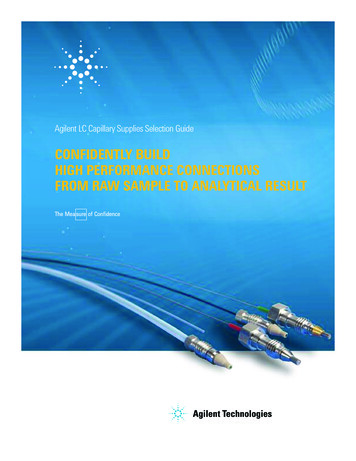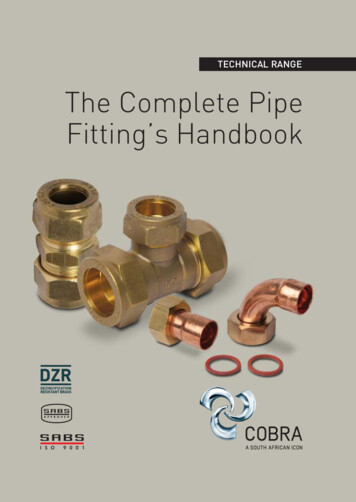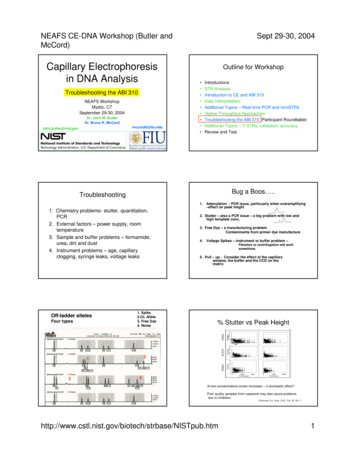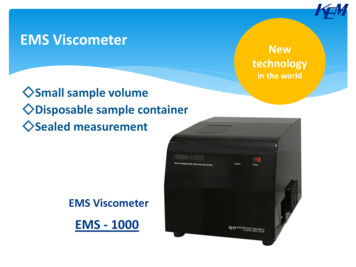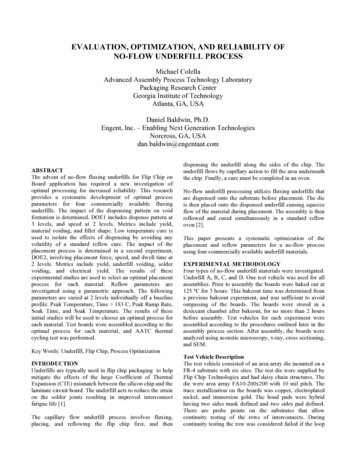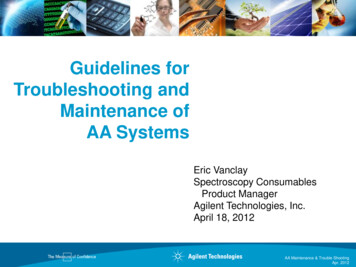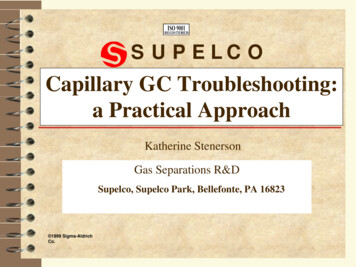
Transcription
SUPELCOCapillary GC Troubleshooting:a Practical ApproachKatherine StenersonGas Separations R&DSupelco, Supelco Park, Bellefonte, PA 16823 1999 Sigma-AldrichCo.
Outline Basic Troubleshooting Strategy Preventing Problems Identifying Common Problems Recommended Reading Discussion 1999 Sigma-Aldrich Co.SUPELCO
Troubleshooting Strategy Have appropriate equipment and supplieson hand. Establish a systematic approach. Know what to look for first. Record what you did to correct the problem. 1999 Sigma-Aldrich Co.SUPELCO
Suggested Equipment to Have on Handfor Troubleshooting: Electronic Leak Detector Flow Meter “Test” Column Replacement Accessories (Syringes,Ferrules, Septa) Replacement Purifiers 1999 Sigma-Aldrich Co.SUPELCO
Five Major Sources of ChromatographicProblems:❶ Operator Error❷ The Sample❸ The Column❹ The GC Electrical System❺ The Gas Flow System (both internal andexternal to the GC) 1999 Sigma-Aldrich Co.SUPELCO
Approaching the Problem Check first to see if a “fix” for the problemis already known. Checkthe Supelco Capillary GCTroubleshooting Guide (Bulletin 853.) Check back in the instrument maintenancerecord. Talk to others in your lab. 1999 Sigma-Aldrich Co.SUPELCO
Isolate the Source of the ProblemOKCheck operatingparametersRun Ref. Std.Not OKCorrect theparameterNot OKOKInstallTestColumnProblem wassamplerelatedOKNot OKProblem is in the Inletor with the carrier gasOKProblemwasColumn related 1999 Sigma-Aldrich Co.Cap offDetectorNot OKProblem is in theDetectorSUPELCO
When reviewing operating methodparameters consider the following:? Is my starting temp. low enough to allowsufficient sample focusing? For splitless injections, is my splitter opening atthe appropriate time? Is my column flow set to give me maximumefficiency at the most critical point? Are heated zones (injectors, detectors, interfaces)set appropriately? 1999 Sigma-Aldrich Co.SUPELCO
The Best Way to Solve Problems is toPrevent Them! Install and maintain proper purification forall gases in the GC system. Maintain the injector by periodicallyinspecting and changing the liner, septa,and seal (H/P .) Use the proper injection technique-thisincludes using the right liner for the job. When necessary, use a guard column toprotect the analytical column. 1999 Sigma-Aldrich Co.SUPELCO
Gas Purification Carrier Gas– At minimum, remove hydrocarbons, water, and oxygen. Hydrogen (FID)– At minimum, remove hydrocarbons. Air (FID)– At minimum, remove water and hydrocarbons. Nitrogen make-up (FID, ECD)– At minimum, remove hydrocarbons. P-5 make-up (ECD)– At minimum remove hydrocarbons (especially halogencontaining), oxygen. 1999 Sigma-Aldrich Co.SUPELCO
Acceptable Purity Levels forChromatography Grade GasesImpurity / Maximum hane 1999 Sigma-Aldrich Co.O2 1.0 ppm 1.0 ppm20-22% 1.0 ppmH2O 1.0 ppm 1.0 ppm 1.0 ppm 1.0 ppmCO2 1.0 ppm 1.0 ppm 1.0 ppm 1.0 ppmCO 1.0 ppm 1.0 ppm 1.0 ppm 1.0 ppm 1.0 ppm 1.0 ppm 1.0 ppm 1.0 ppmTotalHydrocarbons 1.0 ppm 1.0 ppm 1.0 ppm 1.0 ppm 1.0 ppmSUPELCO
Suggested WaterOxygenMole Sieve 5AOMI -2H2Mole Sieve 5AAirN2 makeupP-5P-5 1999 Sigma-Aldrich Co.OMI -2OMI -2SUPELCO
What are some signs that my purifiersneed to be changed?Hydrocarbon TrapsMolecular Sieve 5ANoise in the baseline (FID)Increase in column bleedIncrease in background peakson tune (MSD)Water visible in MSbackgroundHigher than normal baselinereading on FIDPoor peak shapes for gaseousVOCs (purge and trap)Extra peaks visible in runExtra peaks visible in runOMI -2 color change 1999 Sigma-Aldrich Co.SUPELCO
Injector Maintenance Change (as needed):1. Liner and O-ring*2. Seal and washer **H/P GCs Inspect the inlet periodically-Look for contamination in the liner-Look for residue on the seal 1999 Sigma-Aldrich Co.SUPELCO
Using the right liner and injectiontechnique can also prevent problems: Split Injection– used for concentrated samples– high flow of carrier gas through liner duringinjection– should use liner designed for split injection Splitless Injection– used for trace analysis– low flow of carrier gas through liner duringinjection– inertness and internal volume of liner used arecritical 1999 Sigma-Aldrich Co.SUPELCO
Some liners used for split injectionCup (unpacked)Cup (wool packed)Split/splitless- wool packed 1999 Sigma-Aldrich Co.SUPELCO
Some liners used for splitless injection2 mm ID, straightDual-taperedSingle-tapered 1999 Sigma-Aldrich Co.SUPELCO
If you must clean a liner . Handle liners with gloves or forceps. Use clean compressed gas and/or a finebrush to remove particles. Rinse liner in an appropriate solvent anddry with clean compressed gas. Use mineral acid and/or detergent only ifabsolutely necessary. 1999 Sigma-Aldrich Co.SUPELCO
Using a Guard Column Choose a guard column which has beendeactivated. Usually, the ID of the guard matches theanalytical column. A 5-10 meter length is normally used. Connect with either a GlasSeal or buttconnector. 1999 Sigma-Aldrich Co.SUPELCO
Common Problems1 Poor Peak Shapes (either tailing, fronting,23456or just generally ugly.)NonlinearityBaseline Noise and /or DriftGhost PeaksMissing Peaks / Poor ResponseInsufficient Resolution 1999 Sigma-Aldrich Co.SUPELCO
1. Poor Peak Shapes Fronting can indicatecolumn overload. Tailing can indicateactivity in the system orimproper columninstallation. 1999 Sigma-Aldrich Co.SUPELCO
1. Poor Peak Shapes (cont.) Generally ugly peaks,such as a,adimethylphenethylamine,can be caused by avariety of problems. 1999 Sigma-Aldrich Co.SUPELCO
2. NonlinearityThe most common causes are: Column overload Detector overload Standards preparation Poor peak shape resulting in improperintegration 1999 Sigma-Aldrich Co.SUPELCO
An Example of Overload:Peaks have broad bases,fronting on last few visible inrun. 1999 Sigma-Aldrich Co.SUPELCO
Preventing column overload for splitlessinjections: Inject a smaller amount / use a 1 ul syringe. Use a thicker film column. Use a column with a wider ID. Decrease upper limit of calibration range. Use a column of slightly different polarity. 1999 Sigma-Aldrich Co.SUPELCO
An example of poor peak shape affectinglinearity: Benzoic acid istypically of poorshape when doingsplitless injections. 1999 Sigma-Aldrich Co.SUPELCO
3. Common causes of baseline noise /drift. Column bleed Dirty detector Contaminants in carrier gas / carrier gaspurity 1999 Sigma-Aldrich Co.SUPELCO
Effect of carrier gas purity on 08000H2 carrier from 0015001000500H2 carrier from a generator01 1999 Sigma-Aldrich Co.SUPELCO
Column bleed results from the normaldegradation of the stationary phase. All columns bleed to some extent. Bleed increases with temperature. The amount of bleed will increase in thepresence of oxygen. 1999 Sigma-Aldrich Co.SUPELCO
A Typical Bleed Profile:2Bleed measured as thedifference between 1 and 2.14 1999 Sigma-Aldrich Co.SUPELCO
Column Bleed on an MSD Visible as baseline rise in the TIC. Check spectra for key bleed ions:– PTE -5: 207, 281– SPB -1: 73, 207, 281– SPB -624: 207, 269 Make sure interface temp. is columnmax. temp. 1999 Sigma-Aldrich Co.SUPELCO
Ion 207 corresponds to a fragment known as D3:CH 3CH 3SiOO SiSiCH 3OCH 3CH 3 1999 Sigma-Aldrich Co.SUPELCO
MS spectra of bleed from a PTE -5 ColumnAbundanceScan 2895 (27.487 min): 50406080 100 120 140 160 180 200 220 240 260 280 300 320 340 360 380 400m/z-- 1999 Sigma-Aldrich Co.SUPELCO
MS spectra of bleed from an SPB -1 ColumnAbundanceScan 1941 (28.793 min): 250014720002813411500100096 119500179253313401429040 6080 0m/z-- 1999 Sigma-Aldrich Co.SUPELCO
MS spectra of bleed from an SPB -624 ColumnAbundanceScan 8581 (33.704 min): 60119177163223239283322 34329880 100 120 140 160 180 200 220 240 260 280 300 320 340m/z-- 1999 Sigma-Aldrich Co.SUPELCO
MS Spectra of Septa BleedAbundanceScan 604 (7.460 min): 14000120001000080006000400032745207200013195 1150406016319122325129734341539938380 100 120 140 160 180 200 220 240 260 280 300 320 340 360 380 400 420m/z-- 1999 Sigma-Aldrich Co.SUPELCO
Prevent column bleed! Sufficiently purge column with carrier beforeramping it up in temperature. Make sure carrier gas is filtered for water andoxygen. Check integrity of all fittings leading to thecolumn. Do not heat the column above its maximum temp. Precondition the column prior to use. 1999 Sigma-Aldrich Co.SUPELCO
4. Ghost Peaks Residue in the inlet liner and at the head ofthe column Contaminated syringe / and or washsolutions on an autosampler. Sample carryover Contaminated carrier gas 1999 Sigma-Aldrich Co.SUPELCO
If pieces of septa get into an inlet liner.220000020000001800000Response test mix, 002000000 1999 Sigma-Aldrich Co.SUPELCO
even a simple analysis can be ruined.350000030000002500000Response test mix, after2000000150000010000005000000Time-- 1999 Sigma-Aldrich Co.SUPELCO
5. Missing Peaks / Poor Response Sample decomposition– Activity in the inlet or column– Injection port temperature too high– Sample not stable enough for GC– Standards not stable Coelution Insufficient run time / final temperature Sample not volatile enough for GC Improper column installation 1999 Sigma-Aldrich Co.SUPELCO
Nasty samples can damage a columnby creating active 5-dinitrophenolBefore Sample Injection450000100000500000 1999 Sigma-Aldrich Co.SUPELCO
Here, the responses of some acidswere 0Pentachlorophenol should be here900000After sample injection2-methyl-3,5-dinitrophenol2,4-DNP & 4-NP should be hereAbundance1000000Time-- 1999 Sigma-Aldrich Co.SUPELCO
Response can also be affected by theposition of the column in the inlet:28000002600000240000022000008 mm above top of 000006000004000002000000 1999 Sigma-Aldrich Co.SUPELCO
Here, the column was not inserted farenough:22000002000000180000016000005 mm above top of 000 1999 Sigma-Aldrich Co.SUPELCO
Here, the column was inserted too far:180000016000001400000120000020 mm above top of ferrule10000008000006000004000002000000 1999 Sigma-Aldrich Co.SUPELCO
6. Insufficient Resolution Wrong column– Longer columns increase resolution.– Smaller ID columns increase resolution.– A different phase altogether may be needed. Wrong Conditions– Carrier gas flow too fast or slow .– Oven ramp rate too fast. 1999 Sigma-Aldrich Co.SUPELCO
Recommended ReadingSupelco Bulletins1.2.3.4.5.741:783:853:875:895:6. 897:7. 898:8. 899:9. 916:10. 918:The Supelco Guide to Leak-Free ConnectionsCleaning Flame Ionization DetectorsCapillary Troubleshooting GuideSupelco Capillary GC Selection GuideInstallation and Maintenance Instructions for .25mm and .32 mm ID Fused Silica Capillary ColumnsInstallation and Maintenance Instructions for .53mm ID Fused Silica Capillary ColumnsGas Management Systems for GCCapillary GC Inlet Sleeve Selection GuidePurge and Trap System GuideSelecting Purifiers for Gas Chromatography 1999 Sigma-Aldrich Co.SUPELCO
Help is just a phone call or mouseclick away! Supelco Technical Servicephone: 1-800-359-3041email: techservice@supelco.sial.com Supelco Customer Servicephone: 1-800-247-6628email: supelco@sial.com Sigma-Aldrich Websitewww.sigma-aldrich.com 1999 Sigma-Aldrich Co.SUPELCO
Noise in the baseline (FID) Increase in background peaks on tune (MSD) Higher than normal baseline reading on FID Extra peaks visible in run Molecular Sieve 5A Increase in column bleed Water visible in MS background Poor peak shapes for gaseous VOCs (purge and trap) Extra peaks visible in run OMI -2 color change

